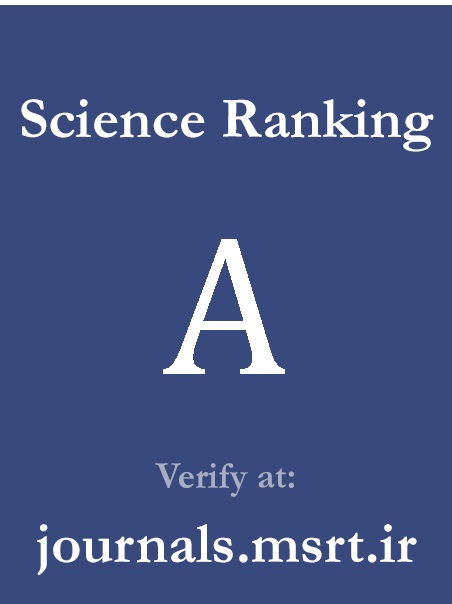A Predictive Model of High-Risk Sexual Behaviors in Female High School Students Based on Cognitive Emotion Regulation Styles with the Mediating Role of Hardiness
Keywords:
High-risk sexual behaviors, cognitive emotion regulation styles, hardinessAbstract
Purpose: This study aimed to develop and test a predictive model of high-risk sexual behaviors among female high school students based on cognitive emotion regulation strategies, with psychological hardiness as a mediating variable.
Methods and Materials: The study employed an applied, descriptive-correlational design using structural equation modeling. The sample included 300 female students from second-cycle high schools in Babol city during the 2022–2023 academic year, selected via non-random, voluntary sampling. Data were collected using standardized questionnaires: the Sexual Risk Behaviors Questionnaire, the Cognitive Emotion Regulation Questionnaire (CERQ), and the Hardiness Profile. Validity and reliability of the instruments were confirmed. Data analysis involved SPSS v25 and SmartPLS software for path analysis and hypothesis testing.
Findings: Results indicated that negative cognitive emotion regulation strategies positively predicted engagement in high-risk sexual behaviors (β = 0.736) and negatively predicted psychological hardiness (β = –0.742). Conversely, positive regulation strategies were associated with decreased risky sexual behaviors (β = –0.738) and increased hardiness (β = 0.744). Psychological hardiness negatively predicted risky sexual behaviors (β = –0.748) and mediated the relationships between both positive and negative regulation strategies and risky behaviors. All hypothesized paths were statistically significant at p < 0.01, with model fit indices supporting the structural model’s adequacy.
Conclusion: The study confirms the significant direct and indirect roles of cognitive emotion regulation strategies in predicting high-risk sexual behaviors among female adolescents, with psychological hardiness serving as a key mediating protective factor. These findings highlight the importance of fostering adaptive emotion regulation and resilience in interventions aimed at reducing sexual risk-taking in adolescent girls.
Downloads
References
Afzali Ziyarani, M., Qorbanpour Lamejani, A., & Seyyadi, A. (2023). Examining the structural relationship between perceived parenting styles and the tendency towards risky behaviors in first-cycle secondary school students: The mediating role of general self-efficacy and psychological resilience. Social Work Quarterly, 12(1), 49-62. https://www.google.com/url?sa=t&source=web&rct=j&opi=89978449&url=https://civilica.com/doc/1939232/&ved=2ahUKEwiT4vijoq2OAxUeQ_EDHb2UORkQFnoECB4QAQ&usg=AOvVaw2o1nJWgXW2WBCnlZj6rnBZ
Ahadi, R., Mohammadi, S., & Taghrangar, H. (2021). Investigating environmental factors affecting addiction to industrial drugs: A case study of Zanjan City. Legal Research, 20(45), 149-181. https://www.google.com/url?sa=t&source=web&rct=j&opi=89978449&url=https://jlr.sdil.ac.ir/article_129111.html&ved=2ahUKEwi1psWyoq2OAxX9QvEDHfJkGgsQFnoECBYQAQ&usg=AOvVaw0B7cS-epVIwB5Syp8NzVuf
Alenezi, F. N., Hashim, S. B., Alanezy, M., & Alharbi, B. F. (2024). The Mediating Effect of Optimism and Resourcefulness on the Relationship between Hardiness and Cyber Delinquent among Adolescent Students. Open Education Studies, 6(1), 20240014. https://doi.org/10.1515/edu-2024-0014
Bartone, P. T., McDonald, K., & Hansma, B. J. (2022). Hardiness and burnout in adult US workers. Journal of Occupational and Environmental Medicine, 64(5), 397-402. https://doi.org/10.1097/JOM.0000000000002448
Basiru, T., Adereti, I., Umudi, O., Ezeokoli, A., Nwoye, I., & Hardy, O. J. (2024). Do Cigarette Smoking and Amphetamine Use Predict Suicide Behaviors among Adolescents in Liberia? Findings from a National Cross-Sectional Survey. International journal of mental health and addiction, 22(1), 199-215. https://doi.org/10.1007/s11469-022-00867-1
Blann, A. (2023). Personal Hardiness as an Unexamined Component of the Healthy Volunteer Effect Doctoral dissertation, Walden University]. https://search.proquest.com/openview/234bbdc64a26ea97a1f62e4a16d9d6c3/1?pq-origsite=gscholar&cbl=18750&diss=y
Chalooyi, N., Jahromi, F., & Jahromi, Q. (2023). The effectiveness of sexual skills training on knowledge, attitudes, and risky sexual behaviors among adolescent girls enrolled in first-cycle secondary school in Tehran. Community Health, 17(2), 73-83. https://www.sid.ir/paper/1154551/fa
Cho, H. S., & Yang, Y. (2023). Relationship between alcohol consumption and risky sexual behaviors among adolescents and young adults: a meta-analysis. International Journal of Public Health, 68, 1605669. https://doi.org/10.3389/ijph.2023.1605669
Chuning, A. E., Durham, M. R., Killgore, W. D., & Smith, R. (2024). Psychological resilience and hardiness as protective factors in the relationship between depression/anxiety and well-being: Exploratory and confirmatory evidence. Personality and individual differences, 225, 112664. https://doi.org/10.1016/j.paid.2024.112664
Dabir Ghorusi, M. (2022). Predicting risky behaviors in adolescents based on the five-factor personality traits, with the mediating roles of executive functions and emotional regulation Master's thesis, Institute of Higher Education in Literature].
Graham, B. A., Sears, L., Cheung, J., Chodavarapu, S., & Sinclair, R. R. (2024). Money on My Mind: How Does Hardiness Relate to Financial Stress? Journal of Financial Counseling & Planning, 35(1). https://connect.springerpub.com/content/sgrjfcp%3A%3A%3A35%3A%3A%3A1%3A%3A%3A96.full.pdf
Hubach, R. D., O'Neil, A., Stowe, M., Giano, Z., Curtis, B., & Fisher, C. B. (2021). Perceived confidentiality risks of mobile technology-based ecologic momentary assessment to assess high-risk behaviors among rural men who have sex with men. Archives of Sexual Behavior, 50, 1641-1650. https://doi.org/10.1007/s10508-019-01612-x
Kozubal, M., Szuster, A., & Wielgopolan, A. (2023). Emotional regulation strategies in daily life: the intensity of emotions and regulation choice. Frontiers in psychology, 14, 1218694. https://doi.org/10.3389/fpsyg.2023.1218694
Kulak, J. A., Homish, D. L., Hoopsick, R. A., Fillo, J., Bartone, P. T., & Homish, G. G. (2021). Hardiness protects against problematic alcohol use in male, but not female, soldiers. Psychological Services, 18(3), 426. https://doi.org/10.1037/ser0000409
Liu, J., Cheng, X., & Li, J. (2022). Relationship between hardiness and the mental health of funded Chinese college students: The mediating role of social support and the moderating role of an only-child status. Frontiers in psychology, 13, 842278. https://doi.org/10.3389/fpsyg.2022.842278
Margaretha, J., Soetikno, N., & Sari, M. P. (2023). The effect of emotional regulation on risk-taking behaviour in late adolescence. International Journal of Application on Social Science and Humanities, 1(1), 613-620. https://doi.org/10.24912/ijassh.v1i1.25918
McDonald, S. E., Murphy, J. L., Tomlinson, C. A., Matijczak, A., Applebaum, J. W., Wike, T. L., & Kattari, S. K. (2022). Relations between sexual and gender minority stress, personal hardiness, and psychological stress in emerging adulthood: Examining indirect effects via human-animal interaction. Youth & Society, 54(2), 240-261. https://doi.org/10.1177/0044118X21990044
Mina, F., & Amini Manesh, S. (2021). Predictors of risky behavior tendencies in adolescent girls: The roles of emotional dysregulation, differentiation, and self-assertion. Social Psychology Research, 11(44), 183-197. https://www.socialpsychology.ir/&url=http://www.socialpsychology.ir/article_145808.html
Mirzaei Fayyaz Abadi, S., Moulavi, E., & Taheri, N. (2019). The relationship between emotional regulation and cognitive inhibition in the tendency towards risky behaviors among adolescent girls in Mashhad. Journal of Social Psychology, 7(52), 123-136. https://www.noormags.ir/view/en/articlepage/1759391/
Mitchell, E., Rosario-Williams, B., Yeshchenko, I., & Miranda, R. (2023). Cognitive emotion regulation strategies among emerging adults with different self-harm histories. Journal of Affective Disorders Reports, 14, 100638. https://doi.org/10.1016/j.jadr.2023.100638
Mosley, S. C. (2023). An Exploration of the Relationship between Hardiness and Parenting Style in an Adult Sample Doctoral dissertation, Carlow University]. https://search.proquest.com/openview/d128a8ec496a104d0b63a187bdaa29c5/1?pq-origsite=gscholar&cbl=18750&diss=y
Mozaffari, N. (2022). Predicting adolescents' risky behaviors based on neurobehavioral systems and executive functions, mediated by emotional regulation and sensation-seeking Doctoral dissertation, Shahid Beheshti University, Tehran]. https://www.google.com/url?sa=t&source=web&rct=j&opi=89978449&url=https://iranpa.org/
Nelson, J. M., Hurst, J., Hardy, S. A., & Padilla-Walker, L. M. (2024). The interactive roles of religion, parenting, and sex communication in adolescent sexual risk-taking. Applied Developmental Science, 28(3), 346-360. https://doi.org/10.1080/10888691.2023.2209321
Rahman, T., Rogers, C. J., Albers, L. D., Forster, M., & Unger, J. B. (2024). Adverse childhood experiences, acculturation, and risky sexual behaviors in Hispanic young adults: findings from Project RED. The Journal of Sex Research, 61(1), 105-118. https://doi.org/10.1080/00224499.2023.2184762
Sefidrood, M., & Hobbi, M. B. (2023). The Role of Attachment Styles and Cognitive Emotion Regulation in Predicting the Tendency to High-Risk Behaviors in Adolescents. International Journal of Applied Behavioral Sciences, 10(1), 1-8. https://core.ac.uk/download/pdf/585414199.pdf
Singh, D., Azuan, M. A., & Narayanan, S. (2024). High-risk sexual behavior among Malaysian adolescents who use drugs: a mixed-methods study of a sample in rehabilitation. Journal of Substance Use, 1-6. https://doi.org/10.1080/14659891.2024.2329885
Singh, P. (2024). Emotion regulation difficulties mediate the relationship between neuroticism and health-risk behaviours in adolescents. In The Psychology of Health and Illness (pp. 120-139). Routledge. https://doi.org/10.4324/9781032689012-9
Tatari, F., Farnia, V., Momeni, K., Davarinejad, O., Salemi, S., Soltani, B., & Alikhani, M. (2021). Predicting addiction potential based on sensation-seeking, psychological hardiness and assertiveness in students in western Iran: an analytical study. Journal of Substance Use, 26(1), 7-12. https://doi.org/10.1080/14659891.2020.1760371
Willis, J. (2022). Attachment Styles, Deployments, and Perceived Stress of African American Military Spouses Doctoral dissertation, Walden University]. https://search.proquest.com/openview/a5fb289175e8656e5b415d27eaf2e12d/1?pq-origsite=gscholar&cbl=18750&diss=y
Zarei, A., Bagherzadeh, R., Gharibi, T., & Rohani Pour, M. (2020). The tendency towards risky behaviors among adolescents in Bushehr City and the associated factors in 2019. Southern Medicine, 23(6), 554-568. https://doi.org/10.52547/ismj.23.6.554
Zarei, S., Vaziry, S., Shahabi Zadeh, F., & Ahi, Q. (2019). The mediating role of cognitive emotion regulation strategies in the relationship between attachment styles and risky sexual behaviors: Designing and testing a conceptual model. Journal of Behavioral Science Research, 17(3), 400-415. https://doi.org/10.52547/rbs.17.3.400
Downloads
Published
Submitted
Revised
Accepted
Issue
Section
License
Copyright (c) 2025 Mahbobeh Alizadeh Godarzi (Author); Akbar Mohammadi; Alireza Pirkhaefi (Author)

This work is licensed under a Creative Commons Attribution-NonCommercial 4.0 International License.










